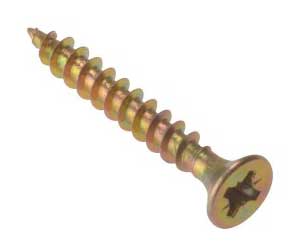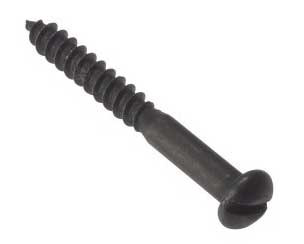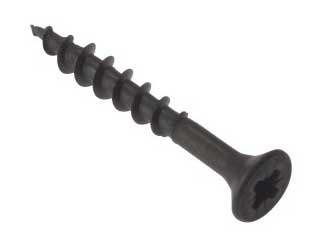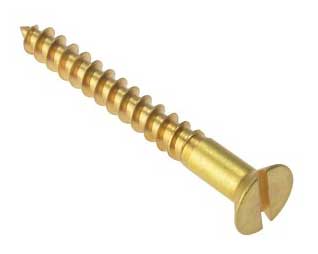Different types of screw do many different types of job and as with everything else in the construction industry and DIY world, the job is much much easier with the right tools, equipment and products.
Wood screws are great for holding wood but you should not use them for metal. Decking screws are for decking, but not for MDF. Different types of screw should be used internally and externally in many cases. If you understand why, it is much easier to know what screw you should choose.
Another area of confusion is which size screw that you should use, and how to work out this size when the sizes are quoted in metric and imperial measurements! This is a whole different story so please take a look at our table of screw sizes here.
Screw sizes vary and generally the larger the number the bigger they are. For example a number 6 screw is much smaller than a number 12.
Additonally, there are many types of fixing for all types of material and circumstances so make sure you get the right one to go with the correct type of screw to make the job as easy as possible.
It is usually much easier to insert screws when you have drilled a pilot hole. This prevents them from binding. Drilling the correct size pilot holes will certainly make screwing down much easier and help to avoid your timber splitting and also countersinking the heads makes for a much neater job so checkout our countersinking and pilot holes project here also.
Selecting the Right Screw for the Material
Use the tables below to work out which screw you should be using for the material (or substrate) that you are working with. If you understand the reason why, this will make it more logical and easier to understand. We Hope!
Screws for Hardwood
| Material / Substrate | Type of screw | Reason | Internal | External |
| Hardwood | Twin thread | Ease of start up and driving | Zinc plated twinthread | Brass or Black Jappaned screws |

Internal use Zinc Plate Twin Thread Screw (ZP TT)

External use Brass Twin Thread Screw
Screws for Soft Wood
| Material / Substrate | Type of screw | Reason | Internal | External |
| Soft Wood | Single thread | Strength in position – High pull-out retention | Zinc plated countersunk | Brass or Black Jappaned screws |

Internal use Single Thread Counter Sunk Zinc Plated Screws (ST ZYP Countersunk)

External use Single Thread Japanned Screws
Screws for Chipboard
| Material / Substrate | Type of screw | Reason | Internal | External |
| Chipboard | Single thread | High pull-out retention | Chipboard Countersunk screws | Do not use chipboard outside unless covered |

Internal use Countersunk Zinc Plated Screws for Chipboard (CSK ZYP)
Screws for MDF
| Material / Substrate | Type of screw | Reason | Internal | External |
| MDF | Single thread with twin thread start – makes the first “biting” twist easy | Twin thread allows ease of start up and single thread provides high pull-out retention | MDF of Carcass Countersunk screws | Do not use MDF outside unless covered |

Internal use MDF screw – Available from Amazon here

Internal use alternate suggestion of Carcass screws
Screws for Wood – Traditional Finish
| Material / Substrate | Type of screw | Reason | Internal | External |
| Wood – Traditional finish | Single thread | Traditional finish required to product | Zinc or brass roundhead screws | Brass ditto |

Internal use Round head Zinc Plates Screws

External use Traditional Slotted Brass Screws
Screws for Masonry
| Material / Substrate | Type of screw | Reason | Internal | External |
| Masonry | Single thread – Self tapping case hardened with groove in thread to allow dust to escape | Single thread for hold and drive to grind into masonry | Concrete and Masonry self tapping screws | Frame screws and hammer fixings |

Internal use Concrete Frame Screw

External use Frame Fixings and Hammer Fixings
Screws for Metal
| Material / Substrate | Type of screw | Reason | Internal | External |
| Metal | Self tapper | Cut their own thread into metal | Self Tapping screws | Stainless steel self tappers, ideally or Zinc Plated self tappers |

Self tapping Zinc Plated Screws (ZP)
Screws for Plasterboard
| Material / Substrate | Type of screw | Reason | Internal | External |
| Plasterboard | Drywall screws | Sharp piercing point with twin thread and bugle head for flush finish. Can be collated for speed of insertion | Drywall screws | Not Used Externally |

Internal use Drywall Screws
Screws for Floorboards
| Material / Substrate | Type of screw | Reason | Internal | External |
| Floorboards | Twin thread on the first few mm for fast start, single thread for hold, countersunk head | Ease of start up and high pull-out retention with minimal splitting and a flush finish | Brass crosshead, countersunk screws | Not Used Externally |

Internal use Traditional Slotted Brass Screws
Screws for Decking
| Material / Substrate | Type of screw | Reason | Internal | External |
| Decking | Sharp point, single thread with shank and countersunk head | Pierce surface, strength in position with minimise jacking up and splitting and a flush finish | Decking screws | Deckings screws |

External use Decking screws
Screws for Roofing Sheet
| Material / Substrate | Type of screw | Reason | Internal | External |
| Roofing sheet | Roofing screws | Self-drilling and self-tapping with rubber bonded washer for weather proofing | Roofing hook bolts or mushroom bolts or Aluminium nails | Roofing hook bolts or mushroom bolts or Aluminium nail |

External use Roofing Screws
Screws for Fencing, Garden Furniture and Marine
| Material / Substrate | Type of screw | Reason | Internal | External |
| Garden and marine | Rust resistant – Easy to drive | Resistant to corrosion and speedy insertion | Ulti Mate wood screws | Ulti Mate wood screws |

External use Ulti Mate wood screws – Available here from Amazon
Using the Wrong Screw Type
Never try to use the wrong screw. Not only will it be hard to put in but it may not hold for the job you want to do. For fixing methods to various surfaces, go back to the projects section. Fixing to masonry is a popular task and is worth reading up about in our project, as is fixing items to plasterboard, as this may require a little more strengthening behind the plaster board to get a secure fixing particularly if your are fixing something heavy.
Abbreviations Commonly Used to Describe Screws
There are a number of abbreviations that are used to describe the type of screw.
- ST: Self Tapping; Allows screwing into the material without having to drill a pilot hole, although one can be used if necessary
- CSK: Countersunk
- SCT: Single Thread, Course Thread
- TT: Twin thread
- TFT: Twin Fine Thread
- ZP: Zinc Plated; for corrosion protection
- ZYP: Zinc and Yellow Passivated; a further passivation layer is applied to the zinc coating to provide even greater corrosion protection
Selecting the Right Size Screw
As mentioned above, we do have a project all about the sizes of screws, and how to convert the metric to imperial sizes. This is very helpful, so please have a read, but this project would not be complete without a word on how to select the right size screw for the work that you are doing.
There are no hard and fast rules for choosing the right screw length for the job that you are working on but we do have a few guidelines to follow.
The screw needs to be long and strong enough to hold the parts that you are fixing together, without going right through and sticking out the other side. Its length will be determined by the forces. The more force the longer the screw that will be required to make a sound fixing. It also needs to be long enough to get a secure fixing into the material that is being fixed too.
The direction of the forces that will be applied to the fixing need to be considered. If the force is lateral, or pushing along the joint of the two materials being fixed, then a thicker screw should be used.
When using thicker screws or when fixing brittle materials including some hardwoods, the material can be prone to splitting. Obviously this is not a good thing, so it is wise to drill a pilot hole before screwing in your screw – find out about how to drill pilot holes in the project mentioned at the top of this page.
Consider also, the number of screws that you use. Use as many as you can where warranted, particularly if you are limited, say in the length of screw that you can use. The extra ones added will provide a stronger fixing to make up for the weakness of each individual fixing.
Different Kinds of Screws and Their Parts
We do not cover the different parts of screws in this project, as we are focusing on helping select the right type of screw for the job of materials that you are working with. To find out about the different parts of screw and the different head and thread types see our project here.
Here we have focused exclusively on screw fixings, but there are a great deal of other fixing that are commonly used. These include using screws with plugs, such as rawl plugs. For more information about the options and which is the right choice of fixing, read our Fixings Project mentioned above.
The topic of the different types of screw and how they should be used is a complex one, so we want to keep it simple. The table above will provide you all the information you need to select the type of screw that you need for the material that you are working with. With this information, you will always be able to choose the right one for the work you’re doing.

